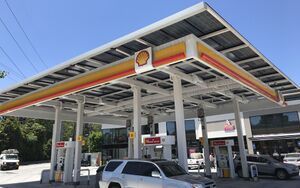Rooftop solar/gas stations

A gas station roof is potentially a good place to put solar panels.
Viability
In peak sunlight, how long might it take to charge one vehicle from 0% to 100%:
https://ev-database.org/cheatsheet/useable-battery-capacity-electric-car
https://www.newport.com/t/introduction-to-solar-radiation
http://www.ftexploring.com/solar-energy/insolation.htm
https://www.safsteelstructure.com/gas-station-roof-design/
Using the example of the "Petro Sun" canopy top which is 15m by 15m
from wikipedia; haven't found original source yet
(calculation loading)
Caveats: [''']- Would take longer if multiple vehicles are plugged in.
- Would take less time if the gas station canopy is bigger.
- Might take longer due to some minor energy losses. Should li_ion.charge_discharge_efficiency be factored in or not?
- The more scaleable solar panels might be less efficient, which would also slow the charging. But the panels would be cheaper, so it might still make economic sense.
- Is a 0%-to-100% charge even a common customer use-case? Maybe solar gas station rooftops could be mostly just for top-ups, which would be fine if they were commonplace.
- Battery/charger capabilities might still limit charge speed in some cases.
If all vehicles were electric, and all gas stations were repurposed with solar panels to the roof, would that alone be enough to charge all the vehicles? Short answer: No. Not even close:
https://www.api.org/news-policy-and-issues/blog/2022/05/26/top-numbers-driving-americas-gasoline-demand
https://www.api.org/news-policy-and-issues/blog/2022/05/26/top-numbers-driving-americas-gasoline-demand
(calculation loading)
Note:
We'd have to build a lot of new solar charging stations (which might still look like gas station roofs). Existing suburban houses could also provide enough rooftop solar for all the vehicles, but people's cars aren't generally parked at home during the day. Then again, that's not a major problem. Suburban homes could dump their excess energy into the power grid which could charge vehicles elsewhere in the city during the day.
Design challanges
- Gasoline pumps are high traffic areas, so you wouldn't want a car to charge right in front of them. You could probably make room for a charging station 10 to 20 meters away. Some extra wires would be necessary. They could either go above ground (beware of interfering with tall trucks) or below ground (probably a high initial cost).
- Gas station roofs also contain anti-fire systems designed to put out a gasoline fire in the rare case it happens. The solar wiring has to not interfere with that. This makes the engineering a bit more complex, but still manageable.
Marketing challanges
Daytime-only charging might be a tough sell now, but less so if it becomes a social norm. One way or another, the customer would have to pay a premium for nighttime charging (due to costs of energy storage) unless the grid has abundant amounts of other baseload power sources.
External links
Examples: